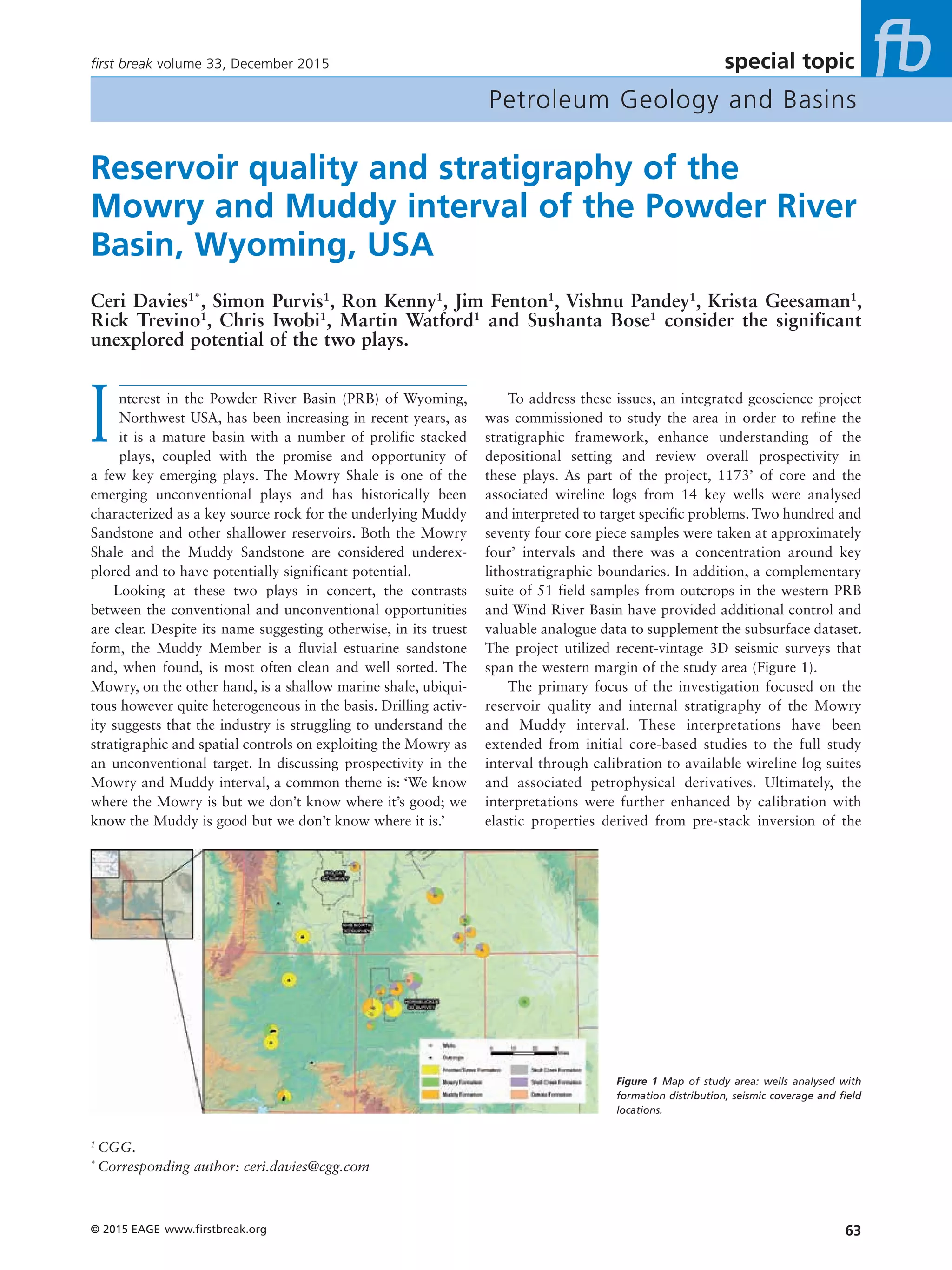The integrated study characterized the reservoir quality and stratigraphy of the Mowry Shale and Muddy Sandstone in the Powder River Basin. Five depositional facies were identified in the Muddy Sandstone based on core and well log analysis, with the cleanest reservoir sands found in tidal inlet and channel deposits. The overlying Mowry Shale consisted of three parasequences deposited in a restricted shelf environment. Seismic inversion and lithofacies modeling were used to map the facies distributions across the 3D seismic volume. The results provide insights into the stratigraphic framework and reservoir characteristics of the two plays to better assess their exploration potential.





![special topic
Petroleum Geology and Basins
www.firstbreak.org © 2015 EAGE68
first break volume 33, December 2015
America. In: Westermann, G.E.G. (Eds.) Jurassic-Cretaceous bio-
chronology and paleogeography of North America. Geological
Association of Canada Special Paper 27, 273-306.
Melick, J.J. [2013] Subsurface description and modelling of geologic
heterogeneity in large subsurface datasets: Using temporal and
scalar hierarchies. Powder River Basin, WY and MT, U.S.A.
Unpublished PhD thesis, Montana State University, Bozeman,
Montana, 237.
Miall, A.D., Catuneanu, O., Vakarelov, B.K. and Post, R. [2008] The
Western Interior Basin. In: Miall, A.D. (Eds.) Sedimentary Basins of
the World, 5, 329-362.
Oliver, G.M., Ly, C.V., Spence, G. and Rael, H. [2013] A new approach to
measuring rock properties data from cores & cuttings for reservoir
& completion characterization: an example from the Bakken
formation. 13URCE-SPE Unconventional Resources Conference and
Exhibition, Expanded Abstracts.
Ufnar, D.F., Ludvigson, G.A., González, L.A. and Gröcke, D.R. [2008]
Precipitation rates and atmospheric heat transport during the
Cenomanian greenhouse warming in North America: Estimates
from a stable isotope mass-balance model. Palaeogeography,
Palaeoclimatology, Palaeoecology, 266, 28-38.
White, T., González, L., Ludvigson, G. and Poulsen, C. [2001] Middle
Cretaceous greenhouse hydrologic cycle of North America. Geology,
29 (4), 363-366.
References
Barron, E.J., Hay, W.W. and Thompson, S. [1989] The hydrologic
cycle, a major variable during Earth history. Palaeogeography,
Palaeoclimatology, Palaeoecology, 75, 157-174.
Brenner, R.L., Ludvigson, G.A., Witzke, B.L., Phillips, P.L., White, T.S.,
Ufnar, D.F., González, L.A., Joeckel, R.M., Goettemoeller, A., and
Shirk, B.R. [2003] Aggradation of gravels in tidally influenced fluvial
systems: upper Albian (Lower Cretaceous) on cratonic margin of
the North American Western Interior foreland basin. Cretaceous
Research, 24, 439-448.
Byers, C.W. and Larson, D.W. [1979] Paleoenvironments of Mowry Shale
(Lower Cretaceous), Western and Central Wyoming. AAPG Bulletin,
63 (3), 354-375.
Castillo, Gt., Voisey, S., Chesser, K., Coevering, N.V.D., Bouziat, A.,
Oliver, G., Ly, C.V. and Kuo, L. [2014] Integrating surface seismic,
microseismic, rock properties and mineralogy in the Haynesville
shale play. First Break, 32, 71-77.
Davis, H.R., Byers, C.W. and Pratt, L.M. [1989] Depositional mecha-
nisms and organic matter in Mowry Shale (Cretaceous), Wyoming.
AAPG Bulletin, 73 (9), 1103-1116.
Dickinson, W.R. [2004] Evolution of the North American Cordillera.
Annu. Rev. Earth Planet. Sci., 32, 13-45.
Kaufmann, E.G. [1984] Paleobiogeography and evolutionary response
dynamic in the Cretaceous Western Interior Seaway of North](https://image.slidesharecdn.com/de892ff6-dd22-40dc-9bfd-1112f0f35542-151209202357-lva1-app6891/75/cggv_0000025472-6-2048.jpg)